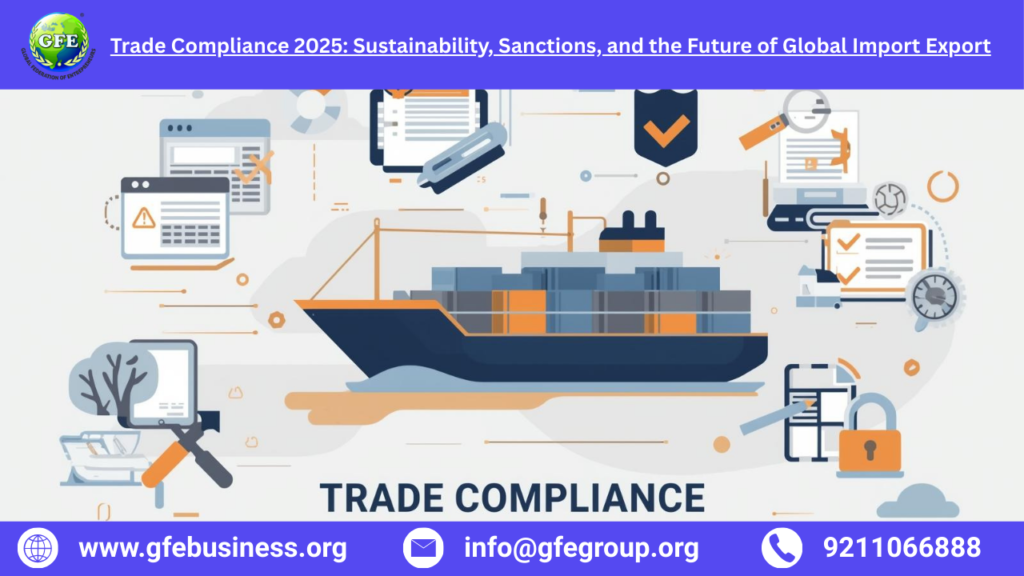Trade compliance 2025 has evolved into more than just filing customs paperwork or adhering to tariff rules. It now includes sustainability standards, sanctions compliance, ESG reporting, and digital customs systems. Import export businesses must understand that non-compliance isn’t just about fines anymore—it can mean losing access to global markets, getting shipments seized, or damaging long-term buyer trust.
With international trade shifting rapidly, platforms like GFE Business are helping Indian exporters decode compliance challenges, from carbon tax rules in Europe to sanctions in the U.S. and advanced digital trade systems worldwide.
Why Trade Compliance in 2025 is More Complex
Unlike earlier, where compliance focused only on tariffs, duties, and customs documents, the landscape has expanded.
Sustainability Regulations – EU’s Carbon Border Adjustment Mechanism (CBAM) now requires exporters to disclose carbon emissions on products.
Sanctions Expansion – Trade with countries under U.S. or EU sanctions could expose exporters to penalties.
Digital Trade Systems – Blockchain-based customs and paperless trade documents are becoming mandatory in several trade hubs.
Data Transparency – Buyers demand ethical sourcing, labor compliance, and ESG reports before finalizing contracts.
This means trade compliance in 2025 is now strategic—not just regulatory.
Key Compliance Trends Defining 2025
1. Sustainability as Core Compliance
Exporters to the EU must comply with carbon footprint disclosures.
Textile exporters must meet eco-labeling and waste reduction rules.
Packaging standards now include recyclable or biodegradable material requirements.
2. Sanctions & Trade Restrictions
Exporters must check global restricted party lists (RPLs) before shipping.
U.S. and EU sanctions extend beyond countries—they include specific companies and individuals.
Example: Indian companies dealing with sanctioned Russian banks risk losing access to U.S. dollar settlements.
3. Digital Customs & Paperless Trade
WTO and UN initiatives are pushing for 100% electronic certificates of origin (eCOs).
Countries like Singapore and UAE already run blockchain-based customs systems.
Importers prefer exporters who can integrate with digital platforms.
4. ESG & Ethical Trade Compliance
European buyers ask for supply chain due diligence reports on labor rights, wages, and working conditions.
Exporters must track sourcing origin to prove no child labor or forced labor is involved.
Risks of Ignoring Trade Compliance 2025
| Risk | Consequence | Example |
|---|---|---|
| Non-compliance with CBAM | Rejection at EU ports | Steel exports denied entry without carbon disclosure |
| Violation of Sanctions | Hefty fines & blacklisting | Exporting goods to sanctioned Russian entities |
| Missing Digital Compliance | Slower clearance, lost buyers | No blockchain integration = delayed shipments |
| ESG Non-Compliance | Loss of contracts | European retail brands cutting off non-certified suppliers |
How Import Export Businesses Can Stay Compliant
Step 1: Map Sustainability Standards
Identify which markets (EU, UK, US, UAE, Japan) have green compliance rules.
Align production with renewable energy, recyclable packaging, and eco-certifications.
Step 2: Integrate Sanctions Screening
Use tools like UN Sanctions List or U.S. OFAC database to check buyers/suppliers.
Automate compliance checks into procurement systems.
Step 3: Adopt Digital Trade Tools
Register for India’s DGFT e-COO portal for paperless certificates.
Use blockchain-based supply chain platforms (Maersk, TradeLens alternatives).
Step 4: Invest in ESG Audits
Conduct self-audits on labor rights, wages, and ethical sourcing.
Partner with certification bodies for SEDEX, Fair Trade, and ISO 14001.
Step 5: Training & Skill Development
Enroll staff in trade compliance courses covering sustainability and sanctions.
Platforms like GFE Business offer compliance-driven import export training.
Case Studies: Trade Compliance in Action
Indian Textile Exporter to EU
Shifted to eco-friendly dyes and recyclable packaging → Secured premium contracts from Germany.Engineering Exporter to Middle East
Adopted blockchain-based COO issuance → Reduced clearance delays by 60%.Pharma Exporter to UK
Implemented sanctions-screening tools → Avoided shipping to a blacklisted distributor.
Career Opportunities in Trade Compliance 2025
With stricter rules, trade compliance professionals are in high demand.
In-Demand Roles
Compliance & Sustainability Officer
Sanctions Compliance Analyst
Global Trade Documentation Specialist
ESG & Supply Chain Auditor
Salary Outlook (India 2025)
Compliance Analyst: ₹8–12 LPA
Sanctions Specialist: ₹10–18 LPA
ESG Trade Consultant: ₹15–25 LPA
Checklist for Trade Compliance in 2025
Conduct sanctions screening before every shipment
File electronic COO under FTAs
Prepare carbon footprint documentation for EU exports
Train staff in ESG compliance
Maintain records for at least 5 years for audit purposes
Final Thoughts
Trade compliance 2025 is not just about avoiding penalties—it is about staying competitive in a global market where buyers, regulators, and logistics partners demand higher transparency. Import export businesses that embrace sustainability, respect sanctions, and adopt digital systems will enjoy faster clearances, premium buyer trust, and stronger global presence.
Platforms like GFE Business can guide exporters in navigating compliance challenges, training teams, and leveraging FTAs, so that compliance becomes a growth driver rather than a burden.
For more, explore:








